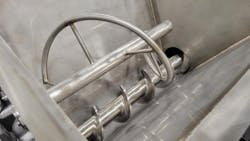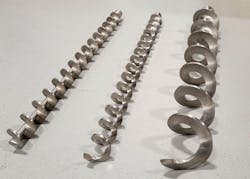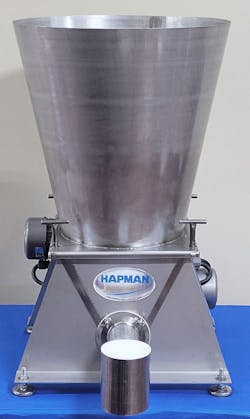Challenges to consider when selecting a screw feeder

Moving dry bulk materials in industrial settings comes with unique challenges, especially when handling substances that are abrasive, sticky, or prone to clumping. These difficult-to-handle materials can disrupt operations, decrease efficiency, and cause excessive wear on equipment. Choosing the right feeder to address these challenges is critical for ensuring consistent performance and minimizing downtime.
Dosing screw feeders are designed to tackle these challenges head-on. This article explores the common issues encountered when moving difficult dry bulk materials and explains how selecting the right feeder features can mitigate these problems, improve process efficiency, and enhance operational safety.
Common challenges when handling difficult materials
Clumping and material bridging. Materials such as flour, cocoa powder, and sugar often clump and bridge inside hoppers, particularly when exposed to moisture or pressure. This behavior disrupts feeding consistency, leading to uneven distribution and process interruptions. For industries such as food production or chemical manufacturing, these inconsistencies can significantly impact product quality and throughput.
Inconsistent material flow. Achieving a uniform flow rate is essential for production environments. However, materials with varying bulk densities or adhesive properties, such as powders with high fat content, can create blockages that disrupt feeding. These interruptions lead to operational inefficiencies and complications in downstream processes.
Abrasive and corrosive wear. Handling abrasive or corrosive materials poses a significant challenge to feeders, often leading to rapid equipment wear and contamination risks. This issue is particularly critical in industries such as pharmaceuticals or food production, where hygiene and material purity are paramount.
Maintenance and safety concerns. Balancing ease of maintenance with operational safety is another challenge. Traditional feeders may require frequent disassembly for cleaning or repairs, increasing the risk of accidents and downtime. Ensuring compliance with safety standards while maintaining efficiency can be a difficult equilibrium to achieve.
Key features to address challenges
Selecting a dosing screw feeder with specific design features can help overcome these obstacles. The following are some key considerations:
An internal agitation system in the feeder hopper is essential for breaking up clumps and preventing bridging. Agitators, driven by independent motors, ensure a consistent flow of material into the screw, even for sticky or cohesive powders. Adjustable agitation speeds allow operators to adapt to varying material properties, enhancing feeder versatility.
Dosing feeders with independent motor controls for the screw and agitator provide greater flexibility and precision. By adjusting these components separately, operators can fine-tune feed rates to match material characteristics, reducing over-agitation and optimizing performance.
Stainless steel construction, particularly grades 304 and 316, offers excellent resistance to corrosion and is easy to clean. This durability ensures that feeders can handle abrasive materials and meet strict hygiene standards required in sensitive industries such as food processing.
Volumetric and gravimetric feeding systems provide tailored solutions for maintaining consistent feed rates. Gravimetric feeders use weight-based measurements for high-precision control, making them ideal for applications where ingredient consistency is critical, such as pharmaceuticals or specialty chemicals.
Modern dosing feeders incorporate enhanced bolt-on safety features, such as nozzles and bar grates, that reduce maintenance complexity while protecting operators. These features prevent accidental exposure to moving parts and ensure compliance with safety standards without compromising operational efficiency.
Customizable components, such as different screw types or extension hoppers, allow dosing feeders to handle a wide range of material properties. From progressive-pitch screws for low-density powders to extension hoppers for increased storage, customization ensures optimal performance.
Best practices for feeder operation
Beyond selecting the right feeder, the following best practices for feeder operation are crucial to ensure long-term reliability and efficiency:
Avoid material buildup. Regularly clearing hoppers of residual materials prevents clogging and contamination.
Conduct material testing. Testing materials for bulk density, moisture content, and flow characteristics helps optimize feeder configurations.
Schedule routine maintenance. Periodic inspections and cleaning ensure that components remain in peak condition, minimizing downtime.
Ryan Coburn is Technical Sales Specialist and Clark Wright is Technical Development Engineer at Hapman. Hapman’s PosiPro dosing feeder is engineered to address the challenges of handling difficult dry bulk materials. Its advanced design features ensure consistent material flow and adaptability for a wide range of applications and its stainless-steel construction offers corrosion resistance and ease of cleaning. For additional material storage Hapman offers a conical extension hopper with the PosiPro feeder that allows for unrestricted flow of material into the feeder and eliminates harborage areas for material to gather. The PosiPro’s bolt-on safety features and customizable components minimize maintenance requirements while enhancing operational safety. Additionally, Hapman provides material testing services to help customers identify the optimal feeder configurations for their specific needs.
Hapman
About the Author
Ryan Coburn
Ryan Coburn is Technical Sales Specialist at Hapman.
Clark Wright
Clark Wright is Technical Development Engineer at Hapman.

